danbricklin.com/log
|
||
|
|
Starting May 27, 2009
VisiCalc turns 30 and SocialCalc turns 1.0, "Signals and the Ubiquity of New Carriers" essay, New York travels and speeches with Palm Pre and netbook, Return to Crested Butte, Essay on new modes of interaction as highlighted by Microsoft Natal and Google Wave, Socialtext is releasing the latest SocialCalc in a wide beta, New SocialCalc release for the OLPC, "What's Next in Tech?" event this week, "What will people pay for?" excerpt, All hail VisiCalc: 30th anniversary of the public announcement of VisiCalc, Reading excerpts from my book, I was on "This Week in Tech"
27May09-19Oct09
2009_05_27.htm
|
|
|
VisiCalc turns 30 and SocialCalc turns 1.0 [link]
According to my notebook from 1979, 30 years ago today Dan Fylstra, head of Personal Software, our Bay Area publisher, told me that he had the first production VisiCalc packages in hand. I received mine the next day (Saturday delivery). So today, for argument's sake, is the 30th anniversary of the shipment of VisiCalc 1.0. (Well, actually, we called it version 1.37, but it was the first packaged version produced and sold in volume.)
Dan's notebook entry from 1979
 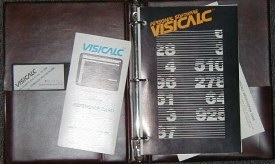 The package and contents: 5 1/4" diskette, reference card, manual, registration card
 Apple II with VisiCalc
Spreadsheets have aged well over those 3 decades. While computers have gotten thousands of times more powerful, and spreadsheets have zillions of additional capabilities, the same basic metaphor of a free-form grid of cells for displaying text and numbers, each backed by formulas and display attributes, along with a simple and natural interface for entering, modifying, and displaying that data, has endured. To me, to have helped bring such a useful and long-lasting tool to the world is very gratifying.
The concept of spreadsheets was not new in 1979. Text and numbers arranged in columns and rows go back a long time. (The 10 Commandments are traditionally shown as two columns of five entries each, hundred-year-old books present data in spreadsheets as a matter of course, and many timesharing programs in the 1970s had "spread sheet" output.) VisiCalc is known, though, as the first of a particular popular set of features implemented on a personal computer. There is a direct line starting with VisiCalc going all the way to today's dominant spreadsheet, Microsoft Excel. (Lotus 1-2-3 could read VisiCalc files and execute them directly. Excel can read 1-2-3 files.)
My original vision (in 1978) was of a handheld calculator that worked as a mouse with a heads-up display to give you a virtual image that made things look as big as the blackboards I sat in front of every day at Harvard Business School. That type of hardware was beyond what I could code for in those days. The spreadsheet concept, though, moved well onto the much less capable popular personal systems of the day -- character-based, stand-alone personal computers like the Apple II and TRS-80.
As personal computing advanced, spreadsheets followed along. The IBM PC was much more powerful with much more memory and better displays. Lotus 1-2-3 (the leader among many) took the spreadsheet metaphor further into that world, taking advantage of the memory and displays. Spreadsheets did quite well in that world.
With the advent of personal computer GUI systems, spreadsheets adapted well, too. Microsoft Excel emerged dominant, keeping the same grid metaphor, but taking advantage of bitmapped displays and laser printers and the increasing amounts of local storage, and wrapping it in a more accessible mouse and keyboard UI. With GUI systems you expect great control of the visual look of the output, and spreadsheets benefited from the addition of customizable cell borders, fonts, and the even more powerful computers and access to database data.
In an early promotional video about Excel for Windows, Microsoft said "Every major advance in hardware has been legitimized by a spreadsheet." Of course, it's not just by a spreadsheet, it's also by a word processor, and now accessing email and having something to do browsing with. But it is true that, at least for business, you expect desktop systems to have spreadsheet capabilities.
In the early 1990's, when I worked at Slate Corporation on software for pen-based computers, I was part of the development of a spreadsheet that took advantage of those systems, even allowing you to scribble "ink" notes into cells and to do operations with simple gestures.
Social software has moved people away from working on their own copies of documents in their own personal silos, shuffling them with email and Fedex from person to person. They now can work together on single shared copies, linked together in a web based upon topical and personal connections. You'd expect the spreadsheet metaphor to go there, too, and it is. (Of course, like the word processing capabilities of wikis, which don't come anywhere near the capabilities of a product like Microsoft Word, you'd wouldn't be surprised if social spreadsheets didn't have every Excel bell and whistle.)
I have had to privilege of being one of the participants in that evolution, and for that today is special, too: Socialtext, the enterprise social software pioneer, is releasing SocialCalc as a production product today. (It has been in various stages of beta for some time.) I wrote the main spreadsheet "engine" code and have helped guide the project. I've been working closely with Socialtext developers to bring spreadsheets to their social software system which already has wiki pages, social networking, microblogging, and more.
Again, the spreadsheet takes on some of the characteristics of the platform. In this case, that means being browser-based, having live linking, both for navigation and for getting information into and out of the sheet, and other attributes like revision history, tagging, and a connection to people's identities. Beta-test customers have used it in ways that show its potential for being an important business tool. Enough of the UI and integration is now complete to let people easily take advantage of it. For more information, see "SocialCalc, the Social Spreadsheet, Comes Out of Beta" on the Socialtext web site.
This is a great milestone for me personally. I've been working on SocialCalc, and its predecessor, wikiCalc, for four years now. It's been really gratifying over the last several months to have the code I've been writing become a common component of the One Laptop Per Child's offering around the world as one of my contributions to the Open Source world. (The release of a production version has been happening there, too, including a Spanish translation that has been done and is being integrated.) Now, finally, I can also see my work contributing to the shipment of a robust shared spreadsheet for the enterprise -- the "wiki" of wikiCalc growing into the "social" of SocialCalc and Socialtext.
You'll find more about the early history of VisiCalc in the History section of my web site and in chapter 12 of my book. There are links to many of my other writings about VisiCalc, including an early version you can run on MSDOS and Windows, on my VisiCalc page. You may also like "The paper I wrote for business school class about VisiCalc in 1978" earlier in this blog.
Happy Birthday VisiCalc! Here's to many more!
"Signals and the Ubiquity of New Carriers" essay [link]
I just added a new essay to the Writings section of my web site. It discusses a simple framework for looking at how advancing technology will affect different players. It shows how different parts of what seem to be one industry may be affected differently. It was inspired by a walk through Manhattan this summer as a tourist.
New York travels and speeches with Palm Pre and netbook [link]
I've traveled to New York City twice in the last couple of weeks, and also did the traveling in Colorado (blogged below) a couple of weeks before that. It's been interesting to see what it's like with the new set of equipment that I carry.
I've been carrying a cell phone since about 1990, and have often traveled with a laptop computer since the mid-1980's when I used the 9-pound Data General/One. Recently I've been carrying a Palm Pre smartphone and an Acer Aspire One netbook. For several months I carried a T-Mobile/Android G1, and I have an iPod Touch and am constantly around people using their iPhones. (My podcast listening is on an iPod nano.)
I love the fact that a netbook pretty much meets all of my needs with respect to email, web surfing, presenting (Powerpoint, photo slides, video, etc.), communicating (Skype, Adobe ConnectNow, etc., with and without video), reading (PDF, rich text), writing, and more. And it does all this with very little weight, fitting in all of the bags, daypacks, etc., I would bring for just my sunglasses and stuff. If it's not overnight, since the battery life has been superb, I don't even bring a power adapter, making it even lighter. My back really thanks those that made that class of machine possible and popular.
Even more of a change has been how I can often just use my phone for everything. If I'm not doing presentation or writing, my phone is usually all I need, even to get a YouTube video or take photos (the Pre's camera is pretty good). Its quick access to email, the web/search, contact info, and maps, has saved me many times when I need to know something. The GPS has helped me not be late when I parked in the wrong place and needed to walk to the right one, and it's helped me navigate when walking to restaurants. I really think twice now about bringing even the netbook.
Yesterday, on this last trip to NYC, I finally think I really felt what's special about the Palm Pre (vs. other smart phones). I was running around town, trying to find a type of place to pick up lunch, contact the place I had a meeting, and do the best navigation between it all. The seamless launching and switching between apps of WebOS is really something. I routinely have a few apps open at once and sometimes need to use them simultaneously. It's great how you just pull the phone out of the holster, slide open the keyboard with one and half hands (which turns it on, too), and type in a name or search query, press Enter, and have a contact ready to call or a Google query answered. Tap on an address and another window (card) has a map showing where it is and where you are. Tap on a card image and you switch from app to app; swipe up and you close one you don't need anymore. It's pretty good for a version 1.0, which bodes well for their future.
I've been looking at the Palm WebOS SDK to see what apps have access to. They still have a ways to go to give you the capabilities I think we'll need to most fully exploit such a device, but then the phone has only been out a few months and the SDK several weeks, so it's early. I hope they move quickly to give us more raw access to the capabilities of the hardware. The iPhone and Android have gotten some pretty cool uses of their systems in some apps thanks to what their SDKs let developers do, and Palm must see this.
I spent yesterday afternoon talking to some of the folks at Six Apart's Manhattan office. Anil Dash had asked me to drop over and we talked about various things and answered questions from some of the staff. Most of it was about history of recent technology and my views on where things were going. I also got to talk with him about my upcoming talk in the evening and he made some useful suggestions of what would be best for that audience.
In the evening I was one of the presentations at the New York Tech Meetup. (You can see the whole thing on their video page.) Anil had helped connect me with Dawn Barber, chair of their board, and a co-founder. She worked it out so that I could show up, talk about my book and other stuff, and even arranged for a bookseller to be there to sell books people could buy (and that I could autograph). Afterwards we went out for dinner with a few people. I got to sit next to founder Scott Heiferman, who also founded Meetup.com and Fotolog.com. (He told me how he had been influenced by some of my early photo blogging here on this site. What a surprise and a great thing to hear!) Nate Westheimer ran the meeting, which included some cool demos from researchers at Columbia and NYU. Anil introduced me and ran the Q&A. The reviews on Twitter of the meeting and my talk seemed quite positive.
Dawn had asked me to show some of my old videos, so I edited together short clips from a few funny ones that I had about spreadsheets. I was able to get my presentation down to about 10 minutes plus the 4 minutes of video, leaving time for Q&A that went on for a while. Given that they usually only allow 5 minutes for a demo and a few more for Q&A, I was happy to get so much time, and worked hard to make the most of it. It was similar to what happened at the Boulder meetup last month (and my presentation was similar, though I added some more slides about what a startup feels like at Anil's suggestion, and I added the video at Dawn's request). This is different than the old days when I'd get 30-45 minutes to talk and take questions, and I'd show 200+ slides of VisiCalc history and more.
Here are some photos:
 Anil Dash at Six Apart's NYC office
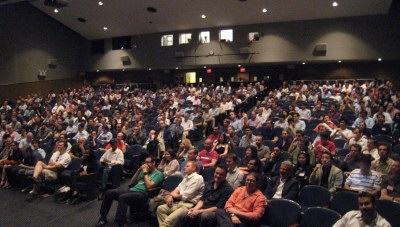 Some of the audience
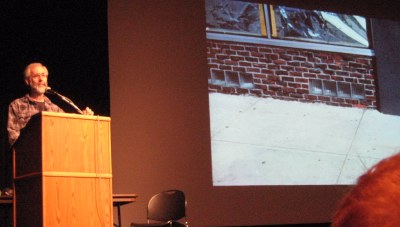 Showing my slides
Return to Crested Butte [link]
Last weekend I attended a family event in Crested Butte, Colorado. The last (and only other) time I had been there was 10 years ago in September of 1999, when I attended the Digital Storytelling Festival. My task at the festival was to cover it with daily posts to a web site -- something we now call blogging. (My task this time at the family event was to enjoy myself, eat, dance, etc.) The company that I was CTO (and founder) of back then, Trellix, produced a tool that could be used to make such sites, and in my presentation at the festival I was able to both show my web postings so far as well as how our tool worked. In those days digital cameras were relatively uncommon and my use of lots of photos as part of my "instant" narrative was something special on my web site. (I had been inspired by Philip Greenspun's wonderful "Travels with Samantha" web site from 1993, which was created with professionally scanned photos from high-end film cameras.)
The festival was a conference that explored using digital media of all sorts for telling stories and communicating them to others, either online or as an adjunct to a live presentation. While we take a lot of this for granted today, it was quite revolutionary back then. The Blogger system was launched by Pyra just the month before the festival and the term "blog" was probably just a few months old. A lot of the lessons that were covered still apply and are worth learning.
The festival was hosted by the late Dana Atchley. On his NextExit.com web site it says: "Digital Storytelling uses computers to create media-rich stories and the internet to share those stories creating communites of common concern on a global scale. Computers are just one more tool in the pantheon of tools that humankind has used to share stories. This includes the pen, moveable type, photography, film and video -- tools that have allowed us first to record and share our stories, and then to reproduce them to be shared by many. Digital stories are all about making connections."
The dual blog of both my trip and the festival itself was originally posted on the webphotojournals.com web site that I used to promote such use of the web (hopefully using the Trellix Web program) and it linked to many RealSlideshows that I and others created using a product from RealNetworks. These "slideshows" were kind of like early YouTube videos and included sound. Unfortunately, the companies that acquired the assets of Trellix didn't keep up the webphotojournals.com domain (it is now owned by a search advertising company of some sort), and RealNetworks stored our work on a temporary site now gone and I haven't found any backups of those (can someone from RealNetworks find them?). I do, though, have the original Trellix file that created my main festival blog site and I got permission a while back to repost what was on webphotojournals.com on bricklin.com. You can find www.webphotojournals.com as www.bricklin.com/webphotojournals and the festival report at the link www.bricklin.com/webphotojournals/dstory, and also an essay about Dana and digital storytelling.
I found it really interesting to re-read what I wrote back then, reporting on the presentations of others, including very early blogger Justin Hall (Thursday afternoon) and the late author Douglas Adams (Friday morning and in a detailed writeup). The web site uses the framed design with a "map" that was part of the Trellix product to show you the structure of the whole site and help with navigation.
If you are a student of the history of blogging and online usage, my report of what I saw and heard, and how I reacted to it, should be interesting. It is a shame that so many of the links on old sites like this don't work anymore (such as the slide shows and videos, and some other links). Some links, though, do still work, such as to Justin's web site (which goes back to 1994) and Dana Atchley's mother's story about red hair and other links on the "What I learned" page.
See the whole thing: "Digital Storytelling Festival".
Producing this journal of an event and others at the time led me to add a general ongoing journal to my web site a few weeks later in October 1999 and I've been blogging ever since, once in a while producing separate limited-time blogs for special events. (You can find links to some of my other event journals in my album list.)
This trip I spent a much longer time in Colorado. I gave a presentation about my book at the Boulder New Tech Meetup, hiked in Rocky Mountain National Park, did some simple biking around Crested Butte, visited the Black Canyon of the Gunnison, and more. The Crested Butte area is one heck of a wonderful place, and I can see why one of my first cousins settled there.
Here are a few photos:
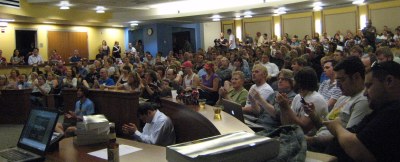 Boulder New Tech Meetup before I spoke -- with a few copies of my book stacked on the edge of the table
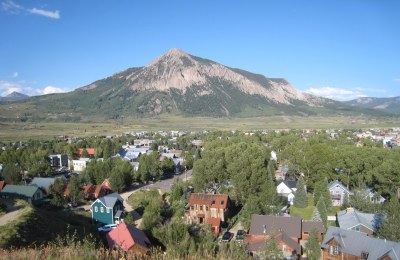 Crested Butte seen from a hill on the side of the town
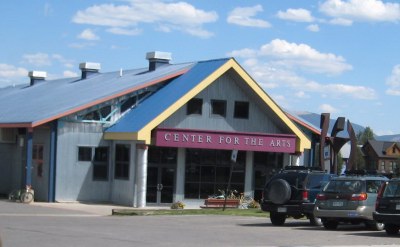 The Center today where the Festival was held 10 years ago
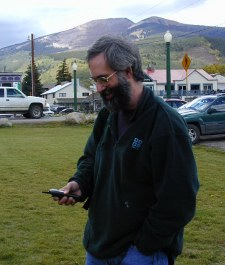 Dan on the phone in 1999 during a lunch break with the side of the Center in the distance
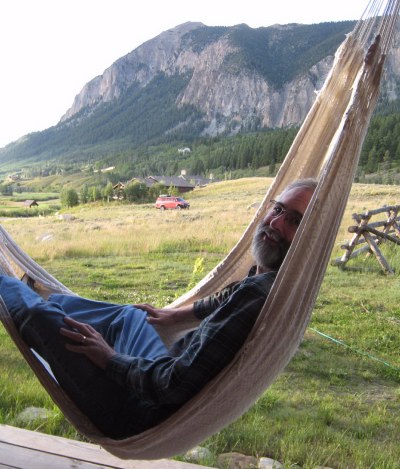 Dan today (photo taken by Nathan Bilow with Dan's camera)
 Rocky Mountain National Park
 Black Canyon of the Gunnison National Park
Essay on new modes of interaction as highlighted by Microsoft Natal and Google Wave [link]
On Friday, June 4, 2009, I was one of the attendees at the Mass Tech Leadership Council's Future of Software and the Internet unConference held over at Sun's campus in Burlington, Mass. I volunteered to lead a session on the topic of "New Modes of Interaction". It was quite successful and led me to write a related essay.
Every once in a while the way we interact with computing power changes. I believe we are about to have some major steps. I wanted to explore what might become the next "common" interaction modes -- something post-GUI, post-cursor / menu / icons. I was inspired by two big announcements in the few days before the conference: Microsoft's Natal and Google's Wave.
Since most of the attendees were not familiar with the announcements, and I felt that they needed to be in order to best serve the discussion, I opened the session by showing two videos as background. I wasn't interested in the specifics of the two products but rather the underlying interaction modes that they brought up and how those may be applied in a more general sense.
We had a great discussion about how things could be changing in the near and further future. Someone even asked me if I could lead a brainstorming session like this at their company.
I've now written an essay that describes and examines some of the implications of the changes I see happening. You can use it as a springboard for more discussion. I'm sure you'll find the videos and links worthwhile.
Socialtext is releasing the latest SocialCalc in a wide beta [link]
This morning Socialtext is announcing that they are releasing SocialCalc (integrated into their enterprise-level wiki) in a wider beta, basically available for test to all of their paying customers. This release includes many advances since their last, much more limited beta release. It includes: Multi-level multi-sheet rollup (the old one only went one level down and didn't recalc that sheet), a much more polished user interface, faster save and load, better integration of advanced wikitext functionality, and all of the other advances in the latest SocialCalc (such as Ctrl-C/V system clipboard support for quick exchange of data with Excel and other applications). Socialtext developers and I have been working a long time to get to this. (While this uses the same basic spreadsheet engine as the OLPC version, it has lots of special Socialtext-specific UI code and makes use of SocialCalc's intersheet reference capabilities as well as Socialtext's online storage, collaboration, and access control functionality.)
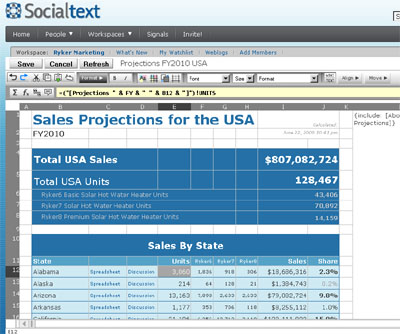 Screenshot of SocialCalc spreadsheet page in Socialtext
For me, this is really a major moment. I finally can do the demo I've been wanting to do for years: A complete budget example with a rollup of 50 states into a country total, with each of the 50 states' pages dependent upon other pages with country-wide values (such as price lists and model factors), and each with a link to a wiki discussion page.
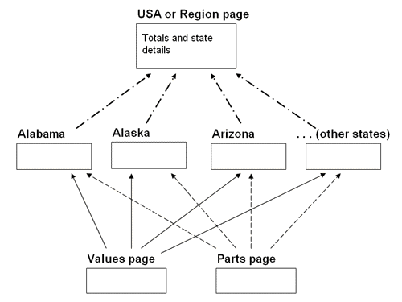 You can change a master model factor (such as default growth or default product mix) or a particular state's values (such as sales growth override value) and then load the USA or regional page and see them all recalculated to provide the latest totals. We are showing that demo at the Enterprise 2.0 conference starting later this morning. I've made a 5-minute Camtasia screencast of the demo that you can look at here. For more information from Socialtext, go to their web site, www.socialtext.com.
New SocialCalc release for the OLPC [link]
This is a very exciting time for the SocialCalc project. For the last year I have been enhancing the main Open Source SocialCalc JavaScript code in various ways, many under the covers, but a few that show up in the user interface (such as a status line with recalc progress, support for Ctrl-C/V, some Move commands, and more).
That code is being used in a few projects. One is at Socialtext (which is paying for most of the development), which is taking the core engine and UI components and enhancing them with a much more polished UI and deep integration into their enterprise-level wiki and social software system. Look to them for some announcements in that regard soon, but not today. What they are doing is really great and achieving some of the main visions I've had for this project, as you'll see.
Other developers have added enhancements to the base code to integrate it onto the One Laptop Per Child's XO computer (and other systems based on the Sugar framework). People have been using earlier versions of this on the XO around the world for the past year. Today they have released a version that integrates XO-specific graphing functionality (needed for educational and other purposes) with my new code. This version is being made much more generally available than the previous early versions. Hopefully, it will result in SocialCalc being a standard component on XO computers.
What's really heartening for me is that the OLPC version involved the work of different people around the world who added new code to complement mine. This version is the basis on which other work is being done in the coming months to add other capabilities and to model and document different uses for schools and for use in microfinance.
You can read about the XO version (version 0.8.3g) on the Software for Education, Entertainment and Training Activities (SEETA) "SocialCalc on Sugar" page. Moving to this stage has been spearheaded by Manusheel Gupta in Delhi, India. Thank you, Manu!
You can read about the latest plain SocialCalc code, version 0.8.3, on the "Software Garden OLPC Home Page". It includes a release of my code (it does not include the new graphing code that is OLPC-specific and that was created by Nicholas Doiron, an engineering student from Carnegie Mellon University, U.S.A. -- that's only in 0.8.3g). You can run a test version there with most modern browsers.
"What's Next in Tech?" event this week [link]
This is going to be a busy week. One event is the "What's Next in Tech: Exploring the Growth Opportunities of 2009 and Beyond" event that Future Forward is hosting at the Boston University School of Management. (I'll be bringing some copies of my book "Bricklin on Technology" to give away.) There are some heavy hitters on both the panel (including Mike Dornbrook, COO, Harmonix Music Systems, the makers of "Rock Band", and Helen Greiner, co-founder of iRobot Corp. and founder of The Droid Works, and a few local venture capitalists who are funding new technologies) and in the audience (well-known bloggers, analysts, young entrepreneurs, other sources of capital, and more).
"What will people pay for?" excerpt [link]
One of my more popular essays is the one on "What Will People Pay For?". A version of it has been reprinted in the Harvard Business Review, and it forms the start of Chapter 2 of my book. As part of posting various excerpts from my book on YouTube, I've added one of me reading that essay along with the blog post about cell phones that follows it in the book.
You can see the excerpts on my book videos page.
My blogging has been sparse again as we approach some new milestones with SocialCalc. (More about those later.) Tweeting (@DanB) is much less overhead and I've continued doing that. I'm working on a new essay, though, that comes out of a session I ran at a Mass Tech Leadership Council unConference.
All hail VisiCalc: 30th anniversary of the public announcement of VisiCalc [link]
On June 4-7, 1979, the National Computer Conference was held in New York City. As a side show, in a hotel down the street, there was a Personal Computing Festival. It was at that show that VisiCalc, the pioneering personal computer spreadsheet, was announced and first shown to the public.
In the general community, even in the general business community, there was little reaction at the time. Unlike today, when an upgrade to an operating system makes the evening news, major news organizations didn't even recognize the significance of this new tool when it was right there in front of their faces. Many individuals who saw VisiCalc demonstrated understood the implications and, when it shipped in late October 1979, brought it into their companies and had a temporary advantage over others. Over the next couple of years, businesses started to understand its value. By the time IBM announced their PC two years later, they made sure to say that it would have VisiCalc and that it would be ready when they first shipped.
30 years later, it is pretty amazing how far we have come. Personal computers are in most homes in the USA. A huge percentage of all people carry a personal computer in their pocket or purse (merged with a wireless telephone) that they use for text, voice, photo, and video communication, and increasingly for computing tasks including games, data organization like calendars and contact lists, and sophisticated graphics rendering. Spreadsheets are taught in grade schools and are used by millions of business people. Many young adults would rather have a laptop computer and an Internet connection than a television.
To commemorate this anniversary, Bob Frankston, who wrote most of the code for VisiCalc, and I, who came up with the specification of what it did, recorded some videos. In mine I read the part of my new book that is about the announcement, including the "almost" news report in the New York Times ("All hail VisiCalc" as part of the article "A Layman's Trip into the Mega-Mega Land of Computers"). Bob reads the entire text of the paper he delivered at the Personal Computing Festival part of the NCC and comments on it.
You can find these videos embedded on "Dan and Bob's Videos About the VisiCalc Announcement in 1979".
Reading excerpts from my book [link]
At the suggestion of various people, I recorded videos of me reading some excerpts from my book. You can see the videos (which are on YouTube) embedded on the "Videos for Bricklin on Technology" page. The first is from the very beginning of the book, followed by the beginning of Chapter 5 on Cooperation. The second video is the section of Chapter 1 titled "The Mindset of an Engineer" and includes a poem that I like as well as a joke with a message.
Over time I will probably record some more excerpts and post them. If you have any favorite passages in the book, let me know.
I was on "This Week in Tech" [link]
As part of publicizing my new book I've been contacting various technology podcasts and radio shows to see if they want a copy and if they'd want me on their show. One of them was the This Week in Tech show (twit.tv). It is mainly a podcast, but also available as streaming video during the show. The host, Leo Laporte, responded that he'd love to have me on the show. I was on it this week, Show 196. I've written up the whole experience of preparing and then appearing on it over Skype video. If you are interested in video, audio, or how the show is done, you might find it of interest.
Here's a photo with Leo and me:
 |
||
|
© Copyright 1999-2018 by Daniel Bricklin
All Rights Reserved.
See disclaimer on home page.
|
||